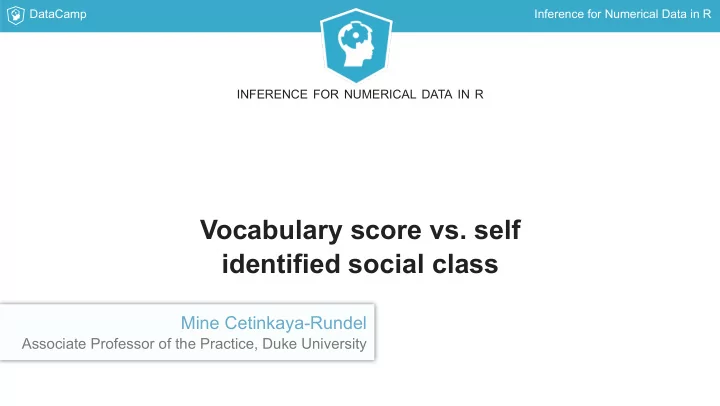

DataCamp Inference for Numerical Data in R INFERENCE FOR NUMERICAL DATA IN R Vocabulary score vs. self identified social class Mine Cetinkaya-Rundel Associate Professor of the Practice, Duke University
DataCamp Inference for Numerical Data in R Vocabulary score and self identified social class wordsum : 10 question vocabulary test wordsum class 1 6 MIDDLE (scores range from 0 to 10) 2 9 WORKING class : self identified social class 3 6 WORKING (lower, working, middle, upper) 4 5 WORKING 5 6 WORKING 6 6 WORKING ... ... ... 795 9 MIDDLE
DataCamp Inference for Numerical Data in R 1. SPACE (school, noon, captain, room, board, don't know) 2. BROADEN (efface, make level, elapse, embroider, widen, don't know) 3. EMANATE (populate, free, prominent, rival, come, don't know) 4. EDIBLE (auspicious, eligible, fit to eat, sagacious, able to speak, don't know) 5. ANIMOSITY (hatred, animation, disobedience, diversity, friendship, don't know) 6. PACT (puissance, remonstrance, agreement, skillet, pressure, don't know) 7. CLOISTERED (miniature, bunched, arched, malady, secluded, don't know) 8. CAPRICE (value, a star, grimace, whim, inducement, don't know) 9. ACCUSTOM (disappoint, customary, encounter, get used to, business, don't know)
DataCamp Inference for Numerical Data in R Distribution of vocabulary score ggplot(data = gss, aes(x = wordsum)) + geom_histogram(binwidth = 1)
DataCamp Inference for Numerical Data in R Self identified social class: class If you were asked to use one of four names for your social class, which would you say you belong in: the lower class, the working class, the middle class, or the upper class? ggplot(data = gss, aes(x = wordsum)) + geom_histogram(binwidth = 1)
DataCamp Inference for Numerical Data in R INFERENCE FOR NUMERICAL DATA IN R Let's practice!
DataCamp Inference for Numerical Data in R INFERENCE FOR NUMERICAL DATA IN R ANOVA Mine Cetinkaya-Rundel Associate Professor of the Practice, Duke University
DataCamp Inference for Numerical Data in R
DataCamp Inference for Numerical Data in R ANOVA for vocabulary scores vs. self identified social class H : The average vocabulary score is the same across all social classes, 0 = μ = μ = μ . μ lower working middle upper H : The average vocabulary scores differ between at least one pair of social A classes.
DataCamp Inference for Numerical Data in R Variability partitioning Total variability in vocabulary score: Variability that can be attributed to differences in social class - between group variability Variability attributed to all other factor - within group variability
DataCamp Inference for Numerical Data in R ANOVA output library(broom) aov(wordsum ~ class, gss) %>% tidy() term df sumsq meansq statistic p.value class 3 236.5644 78.854810 21.73467 0 Residuals 791 2869.8003 3.628066 NA NA
DataCamp Inference for Numerical Data in R Sum of squares term df sumsq meansq statistic p.value class 3 236.5644 78.854810 21.73467 0 Residuals 791 2869.8003 3.628066 NA NA SST = 236.5644 + 2869.8003 = 3106.365 - Measures the total variability in the response variable Calculated very similarly to variance (except not scaled by the sample size) 236.5644 Percentage of explained variability = = 7.6% 3106.365
DataCamp Inference for Numerical Data in R F-statistic term df sumsq meansq statistic p.value class 3 236.5644 78.854810 21.73467 0 Residuals 791 2869.8003 3.628066 NA NA between group var F-statistic = 21.73467 = within group var
DataCamp Inference for Numerical Data in R INFERENCE FOR NUMERICAL DATA IN R Let's practice!
DataCamp Inference for Numerical Data in R INFERENCE FOR NUMERICAL DATA IN R Conditions for ANOVA Mine Cetinkaya-Rundel Associate Professor of the Practice, Duke University
DataCamp Inference for Numerical Data in R Conditions for ANOVA Independence: within groups: sampled observations must be independent between groups: the groups must be independent of each other (non-paired) Approximate normality: distribution of the response variable should be nearly normal within each group Equal variance: groups should have roughly equal variability
DataCamp Inference for Numerical Data in R Independence Within groups: Sampled observations must be independent of each other Random sample / assignment Each n less than 10% of respective population always important, but j sometimes difficult to check Between groups: Groups must be independent of each other Carefully consider whether the groups may be dependent
DataCamp Inference for Numerical Data in R Approximately normal Distribution of response variable within each group should be approximately normal Especially important when sample sizes are small Check with visuals
DataCamp Inference for Numerical Data in R Constant variance Variability should be consistent across groups (homoscedasticity) Especially important when sample sizes differ between groups
DataCamp Inference for Numerical Data in R INFERENCE FOR NUMERICAL DATA IN R Let's practice!
DataCamp Inference for Numerical Data in R INFERENCE FOR NUMERICAL DATA IN R Post-hoc testing Mine Cetinkaya-Rundel Associate Professor of the Practice, Duke University
DataCamp Inference for Numerical Data in R Which means differ? Two sample t-tests for differences in each possible pair of groups Multiple tests → inflated Type 1 error rate Solution: use modified significance level
DataCamp Inference for Numerical Data in R Multiple comparisons Testing many pairs of groups is called multiple comparisons The Bonferroni correction suggests that a more stringent significance level is more appropriate for these tests Adjust α by the number of comparisons being considered k ( k −1) ⋆ α = α , where K = 2 K
DataCamp Inference for Numerical Data in R Pairwise comparisons Constant variance → re-think standard error and degrees of freedom: Use consistent standard error and degrees of freedom for all tests Compare the p-values from each test to the modified significance level
DataCamp Inference for Numerical Data in R INFERENCE FOR NUMERICAL DATA IN R Let's practice!
DataCamp Inference for Numerical Data in R INFERENCE FOR NUMERICAL DATA IN R Congratulations! Mine Cetinkaya-Rundel Associate Professor of the Practice, Duke University
Recommend
More recommend